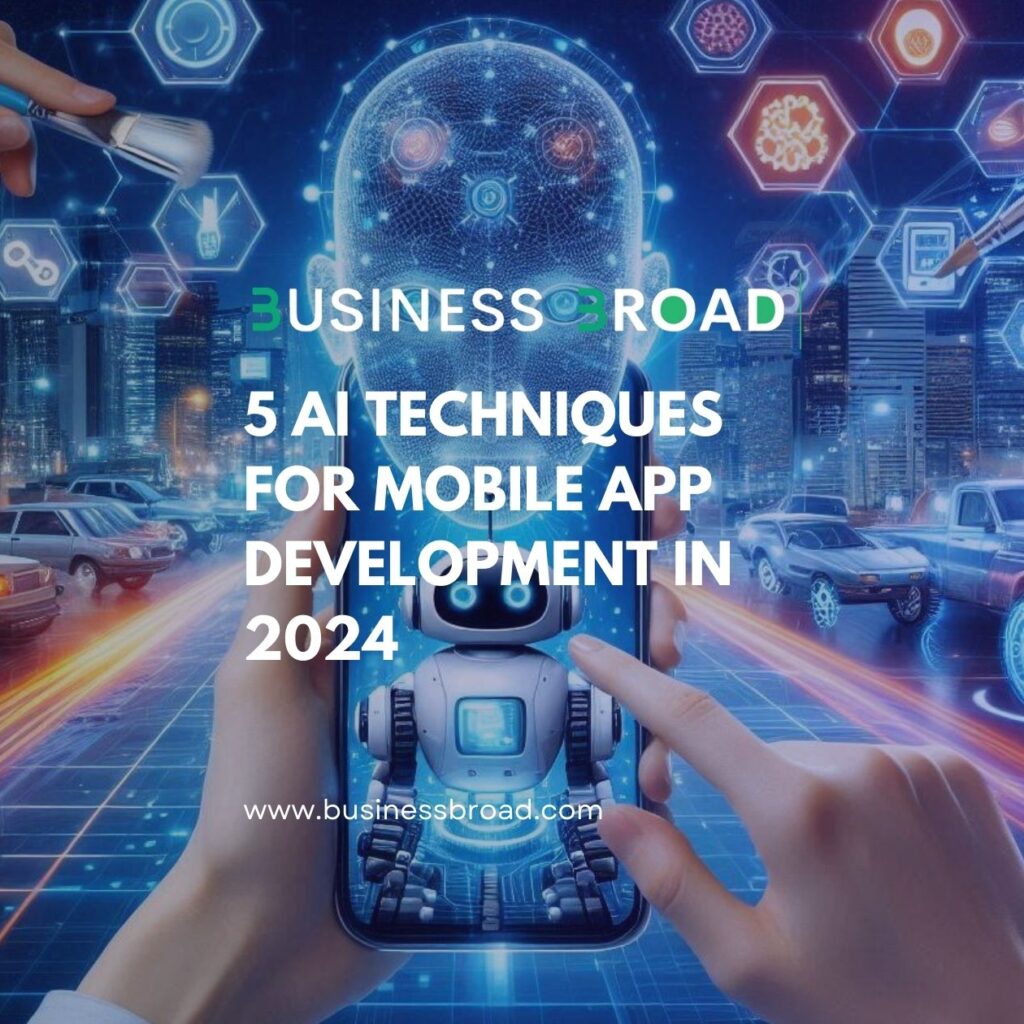In the ever-evolving landscape of mobile app development, artificial intelligence (AI) emerges as a game-changer. As we step into 2024, developers have unprecedented opportunities to harness AI’s potential and create smarter, more personalized apps. In this blog, we’ll explore five effective ways to integrate AI seamlessly into your app development process. Whether you’re a seasoned developer or just dipping your toes into AI waters, this guide will equip you with practical insights to enhance user experiences, streamline processes, and stay ahead of the curve.

Let’s explore 5 effective ways to use AI in mobile app development in 2024:
- Personalized User Experiences:
- Gone are the days of one-size-fits-all app experiences. With AI, your app becomes a personal concierge, tailoring content, recommendations, and even the user interface to each individual user’s unique preferences and behavior.
- AI analyzes user interactions, browsing history, and location data to understand what resonates with each individual. This allows your app to:
- Recommend products or services based on past behavior (e.g., suggesting movies on Netflix or songs on Spotify).
- Deliver content that piques interest (e.g., relevant news articles on Amazon).
- Dynamically adjust the app’s interface for a customized experience.
- The result? Increased user engagement and a loyal user base.
- Intelligent Automation:
- Imagine replacing repetitive tasks with intelligent robots. AI can automate code analysis, debugging, testing, and quality assurance (QA).
- It can also use Natural Language Processing (NLP) for requirements gathering and automate other repetitive tasks.
- By streamlining processes, you free up development time and enhance efficiency.
- Enhanced Code Quality:
- AI-powered code analysis tools can identify potential issues, bugs, and security vulnerabilities.
- These tools help developers write cleaner, more efficient code, improving overall app quality.
- Predictive Analytics:
- AI can predict user behavior, such as churn rates or preferred features.
- By leveraging predictive analytics, you can proactively address user needs and optimize app performance.
- Smart Maintenance:
- AI-driven maintenance can monitor app performance, detect anomalies, and suggest improvements.
- It helps prevent downtime, ensuring a seamless user experience.
How to Implement AI in Existing App?
Implementing AI in your existing app involves several steps. Let’s break it down:
- Assessment and Planning:
- Evaluate your app’s requirements and identify areas where AI can add value. Consider user needs, data availability, and business goals.
- Decide which AI capabilities (e.g., recommendation systems, natural language processing, computer vision) align with your app’s purpose.
- Data Collection and Preparation:
- AI models require data. Gather relevant data from your app (user interactions, behavior, preferences).
- Clean and preprocess the data to ensure its quality and consistency.
- Choose an AI Framework or Service:
- Depending on your expertise, choose an AI framework (e.g., TensorFlow, PyTorch) or use cloud-based AI services (e.g., Azure Cognitive Services, AWS SageMaker).
- These services provide pre-trained models and APIs for various AI tasks.
- Model Development:
- Train or fine-tune an AI model based on your app’s requirements.
- For example:
- Recommendation Systems: Use collaborative filtering or deep learning models.
- Natural Language Processing (NLP): Train models for sentiment analysis, chatbots, or language translation.
- Computer Vision: Develop models for image recognition or object detection.
- Integration:
- Integrate the trained model into your app’s backend or frontend.
- Use APIs or SDKs provided by the chosen framework or service.
- Testing and Optimization:
- Test the AI features thoroughly. Ensure they work seamlessly with the existing app functionality.
- Optimize model performance by fine-tuning hyperparameters and monitoring real-world usage.
- Deployment:
- Deploy the updated app with AI features to production.
- Monitor performance, gather feedback, and iterate as needed.
- User Education:
- Inform users about the new AI features and how they enhance their experience.
- Provide clear instructions or tooltips within the app.
As we navigate the dynamic landscape of app development, AI remains our steadfast companion. The five strategies we’ve explored—personalized experiences, intelligent automation, code quality enhancement, predictive analytics, and smart maintenance—usher in a new era of innovation. Remember, AI isn’t a distant dream; it’s a toolkit waiting to be wielded by developers like you.
So, go forth, experiment, and infuse your apps with the magic of AI. As we step into 2024, let curiosity guide your code, and let data fuel your creativity. The future is bright, and it’s powered by algorithms that learn, adapt, and surprise us at every turn.
Happy coding, and may your apps thrive in this AI-driven world!
ISO 27001: Risk Assessment and Gap Analysis at DevEngineers
GitHub vs GitLab: Unraveling the Battle of Code Repositories





3 Comments
[…] 5 AI Techniques for Mobile App Development in 2024 […]
[…] 5 AI Techniques for Mobile App Development in 2024 […]
[…] 5 AI Techniques for Mobile App Development […]